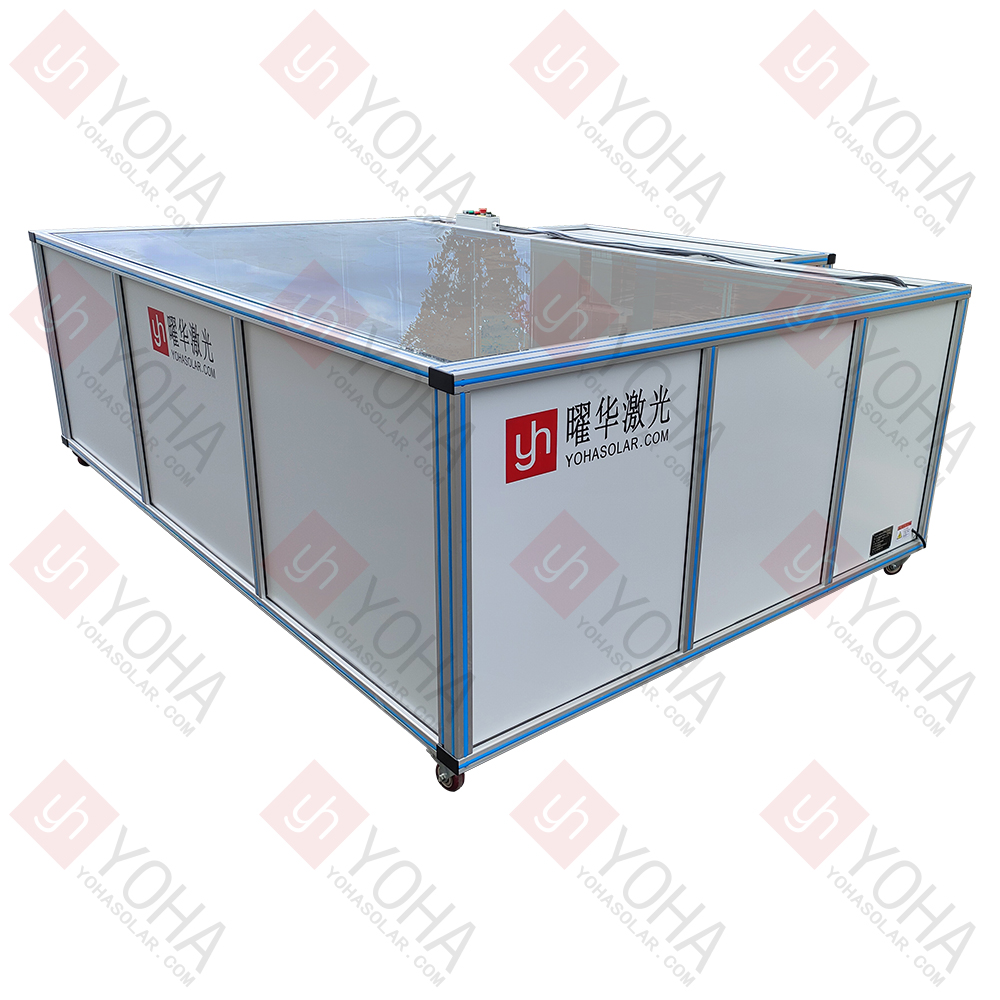Welcome to Wuhan Yoha Solar Technology Co., Ltd!
common problem
Site Map
Language:
 Chinese
Chinese
 English
English
Welcome to Wuhan Yoha Solar Technology Co., Ltd!
common problem
Site Map
Language:
 Chinese
Chinese
 English
English
I. Understanding the Core: What is an EL Tester? Why is it Indispensable?
Before delving into how to choose, we must clarify the working principle and core value of an EL tester.
Working Principle: When a forward bias current is applied to a photovoltaic module, it emits near-infrared light, much like an LED. Internal defects such as cracks, fragments, PID degradation, shunting, and sintering issues will hinder the normal flow of current or the normal emission of photons, causing the luminescence intensity in that area to weaken or cease. The EL tester captures these luminescence images through a highly sensitive camera, converting invisible internal defects into clearly visible "light photographs."
Indispensability: EL testing is the "Keen Eyesight" that runs through the entire process of module R&D, production, quality inspection, and power plant evaluation. On the production line, it can quickly sort out defective products online, preventing faulty modules from reaching the market. At the power plant level, it can assess hidden cracks in modules after transportation and installation, serving as a crucial tool for delineating responsibility and safeguarding power generation revenue.

II. Core Selection Factors: Building Your Evaluation Framework
Choosing a suitable EL tester should not be based solely on price. Instead, a comprehensive evaluation system should be built around the following core dimensions.
1. Detector Type and Sensitivity: The Source of Image "Clarity"
This is the most critical component determining image quality.
Cooled CCD: This is currently the mainstream choice for high-end EL testers. By deep cooling (typically to -60°C or lower), the dark current noise of the chip itself is significantly reduced, allowing for longer exposure times and capturing extremely weak light signals. Its advantages are extremely high image signal-to-noise ratio, rich detail, and excellent consistency. It is very suitable for detecting subtle micro-cracks, early-stage PID, and other hard-to-detect defects. For users seeking the highest quality, requiring quantitative analysis, or using it for R&D, cooled CCD is the preferred choice.
Uncooled CCD/CMOS: These have relatively lower costs and can also obtain decent images when testing intact, normally functioning modules. However, they have inherent disadvantages in signal-to-noise ratio and low-light detection capability. To obtain a sufficiently bright image in a short time, it may be necessary to increase the module current or extend the exposure time, which can sometimes put additional stress on the module and is insufficient for capturing faint defects.
Selection Advice: If your application scenario has high requirements for detection accuracy, stability, and the ability to find subtle defects (such as production line final inspection, laboratory R&D), it is strongly recommended to choose a cooled CCD. It is the cornerstone for ensuring the reliability of test results.
2. Resolution and Field of View: Balancing Image "Fineness" and "Efficiency"
Resolution: Refers to the number of pixels in the camera, determining the fineness of the image. Higher resolution allows for the identification of finer cracks. However, higher is not always better; it must be considered in conjunction with the field of view.
Field of View (FOV): Refers to the area of the module that can be covered in a single shot.
Key Selection Point: You need equipment that can cover the entire module in a single shot while ensuring sufficient pixel accuracy. An important derived metric is "Pixel Resolution", i.e., the actual component size represented by each pixel (e.g., mm/pixel). A smaller value indicates a finer image. Determine the required pixel resolution based on the smallest defect size you need to detect (e.g., hairline micro-cracks), and then select the camera resolution and matching lens focal length accordingly.
3. Detection Efficiency and Automation: The "Pace" Setter for the Production Line
On the production line, the detection speed must match the line cycle time.
Exposure Time: High-quality images require sufficient exposure. Excellent cooled CCDs can obtain clear images within relatively short exposure times (e.g., 1-3 seconds).
Data Transfer and Processing Speed: After capture, image data needs to be quickly transferred from the camera to the computer and processed and displayed. High-speed interfaces and optimized software algorithms are crucial.
Automation Integration Capability: Is the equipment easy to integrate into an automated production line? Does it have standard I/O interfaces, capable of communicating with PLCs, automatically triggering captures, receiving component-in-position signals, and outputting result signals to control sorting mechanisms? This is essential for achieving unmanned, fully automated online inspection.
4. Software Features and Analysis Capability: The "Brain" of the Equipment
Hardware captures the image, but software gives it its soul.
Image Processing Algorithms: Excellent software can enhance image contrast and reduce noise through algorithms, making defects easier to identify.
Automatic Defect Identification and Classification: Does it have automatic identification functions based on AI or traditional algorithms, capable of automatically marking the locations of suspected defects and preliminarily classifying them (e.g., micro-cracks, black cells, broken fingers)? This can significantly reduce the workload of quality inspectors and improve the consistency and efficiency of interpretation.
Data Management and Traceability: Does the software support linking EL images with module serial numbers for storage? Can historical data be easily queried, compared, and can inspection reports be generated? Comprehensive data management is the foundation for quality traceability and process improvement.
5. Light Source and Ambient Light Control: Ensuring the "Purity" of Detection
Darkroom Design: EL luminescence is weak and must be performed in a dark environment. Online equipment is usually equipped with mechanical structures to form a sealed dark box. Ensure its light-blocking effect is good without light leakage.
Excitation Current Source: The equipment should provide a stable, adjustable, and safe constant current source to excite the module to emit light. Its current and voltage output range should cover the specifications of all the modules you need to test.
III. Application Scenario Orientation: Tailoring the Selection to Reality
Your specific application scenario is the ultimate guide for selection.
Production Line Online 100% Inspection: Primary considerations are speed, stability, and degree of automation. The equipment needs to operate stably 24/7, the detection cycle time must be fast, and it must seamlessly integrate with the production line control system. Image quality requirements are high and consistent.
Laboratory R&D and Sampling Inspection: The primary pursuit is ultimate image quality, resolution, and rich analysis features. Detection speed can be slightly slower, but the equipment needs to capture the faintest defect signals and provide detailed quantitative analysis tools (e.g., grayscale analysis, defect statistics).
Power Plant Field Inspection: Primary considerations are portability, power supply method, and environmental adaptability. The equipment needs to be lightweight and portable, support battery power or small generators, and the camera and lens need to have good impact resistance, dust resistance, and moisture resistance.
IV. Beyond the Equipment Itself: Comprehensive Value Considerations
Brand and Technical Support: Choose a supplier with a good reputation and strong technical capabilities. Strong technical support means you can get a quick and professional response when you encounter problems.
After-Sales Service and Training: Understand the supplier's after-sales service network, response time, and whether they provide comprehensive operation and maintenance training. This affects the long-term stable operation of the equipment.
Upgradability and Scalability: Is the software supported by regular updates? Does the hardware platform have room for upgrades? Choosing a product that can grow with your company is a more far-sighted investment.
Summary
Selecting a suitable EL tester is a systematic process of trade-offs. We recommend you follow these steps: Define your core application scenario and accuracy requirements → Based on this, focus on investigating the performance and image quality of the detector → Evaluate its detection efficiency and automation integration capabilities → Deeply experience the software's analysis features and usability → Finally, make a comprehensive decision considering brand, service, and cost.
keywords:TOP
18086473422
MESSAGE
